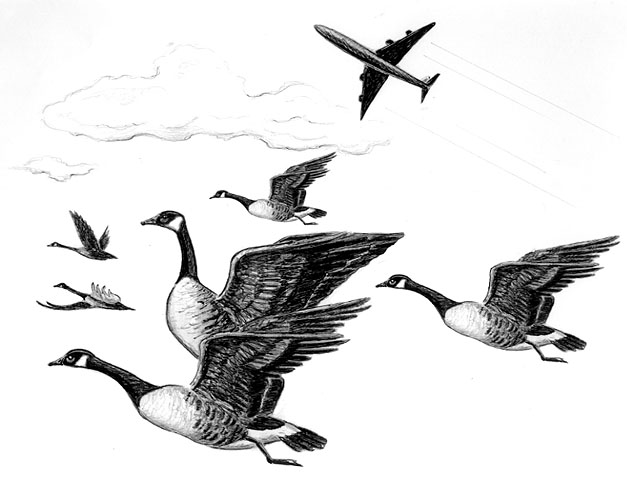
Dear Bird Folks,
In light of the recent “Miracle on the Hudson,” in which a commercial airliner was brought down by a flock of birds, I’d like to know how common bird-plane collisions are. Also, what is being done to prevent further accidents?
– Rick, Andover, MA
Miracle is right, Rick,
I think the entire world is amazed by that story. I get chills just thinking about it. However, after watching every news story about Flight 1549, I could not find a single report that provided information on the condition of the birds that were involved. Are they okay? Are they being treated at an area Audubon sanctuary? Have their family, friends, and flock been notified? Since none of the reporters mentioned the birds’ condition, I have to assume that they are all doing fine and watched the rescue on TV just like the rest of us. Yeah, let’s go with that.
I think it’s clear that birds and planes don’t mix well. The number of annual collisions is reported to be around seven to eight thousand, but I’m not sure how accurate that number is. The actual number may be higher because reporting bird strikes is done on a voluntary basis. Some airlines may decide that it’s easier to simply hose off the bird guts and skip all the paperwork.
Whatever the real number of annual strikes, it appears to be rising. In the early 1970’s bird strikes weren’t nearly as common as they are now. Why the increase? There are more people now and thus more planes needed to carry them. The number of corporate jets alone has quadrupled in recent years, especially since the sweet bailout money has started flowing. In addition, development has pushed the birds out of their preferred habitat and into less desirable locations; i.e., noisy airports. While many species have been negatively impacted by man’s population growth, certain other species, like gulls and geese, for example, have adapted very nicely to all the changes we’ve made to the environment and have thrived. Not surprisingly, gulls and geese are the two biggest avian problems for planes.
The reason we know which birds cause the most problems is because there is actually a lab set up to identify these birds. When a bird hits a plane the remains of the bird, called “snarge,” (yes, you read that right, snarge) are packed up and sent to the Smithsonian in Washington. Once at the Smithsonian, glove-wearing eggheads pick through the snarge and play a game of “Name That Bird.” By knowing which birds cause the most problems, they are better able to advise airports on how to prevent further collisions and additional accumulation of snarge.
Early attempts at scaring birds away from airports were a bit like the tactics some of my customers use to keep the squirrels and Blue Jays off their feeders: They run outside screaming like idiots. While the screaming tactic worked, it also was rather tiring, so more sophisticated methods were developed. These days, airports fire off air cannons, blast shotguns, or let those psycho border collies run loose to keep the birds from moving in. While many of these methods have benefits, habitat management has had the best results. Like us, birds are attracted to food, water and shelter, so special grasses and other vegetation, that have little or no bird appeal, are planted. Mammal populations are kept in check and water is prevented from accumulating. If none of these techniques does the job, then more sinister methods are used. Bird food is laced with airline food and the poor birds don’t have a chance.
No matter what they do to keep birds away some strikes are inevitable so planes are designed with impacts in mind. Jet engines are tested for durability by (wait ’til you read this) having real birds fired into them from bird cannons (that’s right, bird cannons). The companies are quick to point out that they don’t use live birds. (Uh-ha. What do they use? Volunteer birds that have died from old age?) Windshields and other important areas are also reinforced to prevent bird damage. But even with extra protection impacts can cause serious damage. I’ve seen photos of dented nosecones and smashed windshields. In fact, one bird hit a plane with such force that it actually opened one of those little bags of peanuts. Whoa! That’s impressive.
Even though bird accidents are a serious concern, Rick, it should be noted that only one out of every 10,000 flights hits a bird and most of those strikes cause little damage. Worldwide, about ten people die annually as a result of birds hitting planes. While that’s a terrible thing, especially for those ten people, the odds of being on a plane that has a major bird strike are pretty slim, but not as slim as the odds of having your luggage arrive at the same time and location as you do.
As I am writing this column there has yet to be an official announcement as to what really caused both engines to fail on that U.S. Airways jetliner. Early speculation points a finger at a flock of geese. If that turns out to be true, the whole incident will have serious criminal implications, because it would clearly be a case of fowl play. Bet you didn’t see that coming.